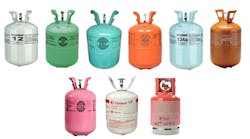Refrigerant Transitions: Q&A for Contractors
The most significant regulatory action related to the use of heating, air conditioning and refrigeration refrigerants is upon us.
The U.S. Environmental Protection Agency wants the HVACR industry to engineer an 85 percent reduction in HFC consumption over the next 15 years. And beyond being a simple switch from one refrigerant to another (as with the R-22 to R-410 transition), this EPA-mandated action is much more significant, as it involves a significant reduction of a wide range of hydrofluorocarbon refrigerants (HFCs). Additionally, the expanding use of A2L (mildly flammable) refrigerants -- prized for their very low global warming potential -- has added a layer of complexity and caution to previously run-of-the-mill refrigerant transition and training processes.
Thankfully, HVACR industry refrigeration thought leaders have been at work disseminating the information HVACR contractors will need to know, and where their compliance will be most required as the months and years go by.
We asked two of those thought leaders – Dr. Charles 'Chuck' Allgood, Technical Fellow, Refrigerants, for Chemours; and Stephen Spletzer, R&D Principal Engineer, Technology, for Chemours – to answer some of the critical questions surrounding this transition. Both are popular presenters at industry events. We thank them for their contribution. - Terry McIver, editor-in-chief
Q: Is it possible to estimate the cost increases that could be associated with phased out refrigerants initially, and as the phase down progresses?
Stephen Spletzer: The short answer is no.
Predicting future refrigerant costs is difficult, especially when considering the many different variables at play here. First, unlike previous refrigerant transitions, this is a phasedown, not a phaseout. While HFC consumption, overall, needs to be reduced by 85% by the year 2036, there is nothing yet to say that a particular HFCAdditionally, the EPA has not yet provided their sector controls on HFC refrigerants. We anticipate that the EPA may establish GWP limits for new systems for several different market segments. High GWP HFC refrigerants may also not be permitted in new systems for end-uses where they are currently used today. This would naturally shift these market segments to lower GWP refrigerant solutions. Historically, the EPA has not banned the use of refrigerants for servicing of the installed base of equipment.
We anticipate that the EPA may establish GWP limits for new systems for several different market segments.
Ultimately, as the phasedown progresses, we anticipate that market dynamics will drive prices. As allocations are reduced in later years, the costs of higher GWP HFC refrigerants may increase relative to lower GWP refrigerant solutions.
Q: What amounts of R-410A will be available for service needs beyond 2023?
Stephen Spletzer: Again, this is a hard one to predict. As this is a refrigerant phasedown and not a phaseout, allocation holders can choose which refrigerant products they “spend their GWP” on. In the earlier years of the phasedown, we expect there will be adequate
R- 410A available for servicing of equipment. However, as R-410A has a relatively higher GWP of 2,088, its availability in the later years of the phasedown will depend on a number of different market dynamics. There are two things however that technicians can do to help ensure an adequate supply of R-410A going forward:
First, don’t simply top off the charge on a leaking R-410A system. Make good faith efforts to find and repair any and all leaks. Second, if you’re not currently returning recovered refrigerant to your local wholesaler or distributor, we recommend you ask about their refrigerant recovery program.
As time goes on, reclaiming of recovered refrigerants like R-410A will play a greater role in supplying the service market. These two items could have a big impact on preserving the supply of R-410A going forward.
Q: Refrigeration Service Engineers Society (RSES) is one of the groups helping to train technicians relative to A2L refrigerant best practices. Is Chemours disseminating information related to A2L refrigerant best practices?
Stephen Spletzer: Chemours has been actively engaged with training organizations to promote education to the HVACR industry on the safe and responsible use of A2L refrigerants. This includes groups like RSES, North American Technician Excellence (NATE), Air Conditioning Contractors of America (ACCA), and ESCO Group. We are also working with the AHRI Safe Refrigerant Transition Task Force (SRTTF) to raise awareness of low GWP refrigerant solutions.
Additionally, we provide both remote and in-person training options for our customers. This is both for the air conditioning market, with products like OpteonTM XL41 (R-454B – a leading replacement for R 410A in new systems), and commercial refrigeration, with products like OpteonTM XL20 (R-454C – a leading replacement for R-22 and R 404A in new systems). More information on an entire range of next generation refrigerant solutions can be found at www.opteon.com.
Be Apart, Be Proactive
Stephen Spletzer: Being proactive with your business and your customers today can help set you apart from the competition. Getting educated on the HFC phasedown and the move to A2Ls is vital – it’s the future of our industry. If you have customers with older equipment running on high GWP refrigerants, like R-404A, educating them on their refrigerant options going forward can also be a win. Retrofitting systems to lower GWP options like OpteonTM XP40 (R-449A) or repairing and replacing leaky systems with next generation solutions can also be good options for your customers. Also, consider compatibility with A2Ls when making future tool purchases for products like leak detectors, recovery machines, gage sets, and vacuum pumps.
Consider compatibility with A2Ls when making future tool purchases for products like leak detectors, recovery machines, gage sets, and vacuum pumps.
Q: Please explain some details related to the eventual ban on disposable refrigerant cylinders.
Dr. Charles Allgood: As part of the AIM Act, the EPA is eliminating the use of disposable refrigerant cylinders. This transition for the US HVACR market from disposable to reusable/refillable cylinders will be starting in 2025. This will be a major change requiring significant investment and may impact the entire supply chain.
Returnable refrigerant cylinders will be similar in appearance to those currently used as “recovery” cylinders.
While the transactional and logistical details are yet to be determined, it is expected that the procuring, tracking, returning, and associated record keeping will be accomplished by the traditional supply chain players such as wholesale distribution. The returnable refrigerant cylinders will be similar in appearance to those currently used as “recovery” cylinders. To address concerns already expressed from some contractors such as increased cylinder weight, working in remote areas such as rooftops, etc., it is Chemours's expectation that typical product package sizes used today, will still be available into the future but may weigh more than the traditional cylinders we use today.
Q: How will the tracking of refrigerant purchases be accomplished?
Dr. Charles Allgood: Similar to current EPA regulations regarding CFC and HCFC refrigerants, we expect the rules for HFCs to limit refrigerant purchases to only certified individuals. Information on the certification process can be found at https://www.epa.gov/section608/section-608-technician-certification-0.
Also, as part of the AIM Act, the EPA is transitioning to refillable cylinders that will include labeling with international QR codes for the stated purpose of tracking legitimate product and avoiding the problem of illegally produced or imported refrigerants from making their way into the US market.
Q: How can end-users best guard against counterfeit refrigerants?
Dr. Charles Allgood: At times of transition in the HVACR industry, particularly when certain products are experiencing price volatility, the problem of fake, counterfeit, or illegally imported product needs to be guarded against. During these times, contractors and service technicians should be extra vigilant when it comes to sourcing refrigerants, always buying from a reliable industry supplier they know and trust. Poor quality, counterfeit, or other illegal refrigerants can present a safety hazard, lead to equipment failures, business disruption, and potentially damage a company’s reputation.
Based on experienced gained through illegal trade of HFCs in the EU, EPA is taking significant steps to address the potential for illegal HFC imports into the U.S. market. Elimination of disposable/recyclable cylinders and QR tracking requirements are two measures intended to deal with illegal refrigerants. EPA is also forming an intergovernmental effort with Customs & Border Patrol, Department of Homeland Security, Department of Justice, and other agencies to coordinate efforts to address illegal imports.
Usually, a key indicator of a counterfeit refrigerant is price, and if a deal seems too good to be true and is much below market norms, exercise extreme caution.
Education is key, so make sure you and your employees know what to look for, what legitimate product looks like, understand current market pricing, as well as knowing what system impacts may occur from using counterfeit material. Usually, a key indicator is price, and if a deal seems too good to be true and is much below market norms, exercise extreme caution. Be very wary of internet “deals”. For years, Chemours has maintained a thorough brand protection program to assist customers in assuring the legitimacy of products. Useful information on how to protect your employees, your customers, and your business can be found at https://www.opteon.com/en/support/helpful-resources/brand-assurance.
If you suspect you may have acquired, or are concerned someone is dealing in illegal or counterfeit materials, the following forms can be used to report the activity to the EPA:
https://www.epa.gov/enforcement/forms/enforcement-contact-us
https://echo.epa.gov/report-environmental-violations


